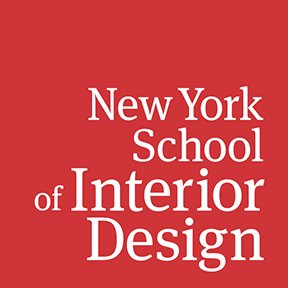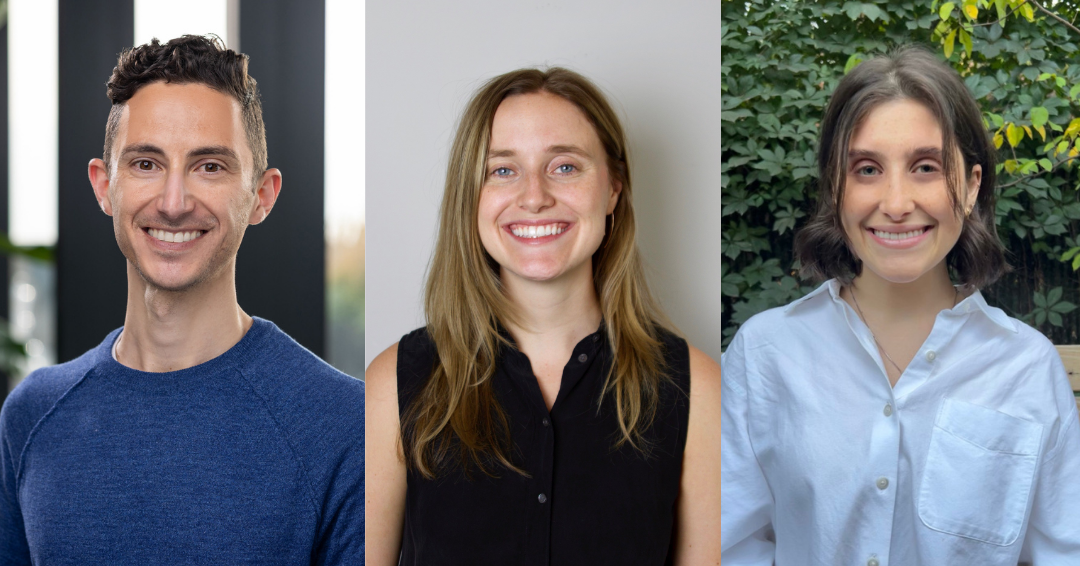Inside the Internship: MFA1 Students Gain Real-World Experience
David Noeller, Meredith Parrot, and Jacqueline Emas
As current students in NYSID’s professional-level Master of Fine Arts in Interior Design (MFA1), David Noeller (MFA1), Meredith Parrot (MFA1), and Jacqueline Emas (MFA1) spent the summer gaining hands-on experience in a variety of design environments, from commercial furniture showrooms to multidisciplinary architecture and design firms. They share with Swagatika Rath (MFA1) how their internships shaped their skills, professional growth, and career perspectives.
Swagatika Rath: Can you tell us about your internship and the type of firm you worked at?
David Noeller: I worked with the interior design team at Creative Office Resources (COR), the nation’s largest MillerKnoll Certified Dealer. They provide furniture and interior construction solutions for corporate, healthcare, and educational spaces.
Meredith Parrot: I interned at Selldorf Architects, a design architecture firm with projects ranging from single-family homes to large public spaces like museums.
Jacqueline Emas: I have been working at Billy Cotton, a distinguished multidisciplinary design firm with a focus on both residential and commercial projects.
How did you find this internship?
DN: The opportunity came through an email from the Office of Career and Internship Services.
MP: I found this internship through Handshake, which is offered through the Office of Career and Internship Services. I recommend browsing it often.
JE: I found my internship through the mentorship of my Interior Design Studio I professor, Leyden Lewis. His guidance helped me recognize my strengths and clarify the direction I wanted to pursue, ultimately leading to the opportunity at Billy Cotton after my first year.
Did you use NYSID’s Office of Career and Internship Services in the process? If so, how was your experience with their support and resources?
DN: Yes, NYSID’s Career Services was instrumental in the process. In addition to sharing the opportunity, they explained how this type of experience could inform my future goals.
MP: I consulted with Career Services throughout the process, and their guidance was incredibly helpful.
JE: No, at that time, I relied on Lewis’s mentorship instead.
What were your main responsibilities and projects during the internship?
DN: I supported a team of over 50 interior designers across the tri-state area on a variety of hands-on projects. My work included preparing AutoCAD plans for import into industry-specific software (CET), adding dimensions to power plans and accurately labeling floor core locations, placing ancillary furniture based on sales specifications, and creating client-facing renderings and presentations.
MP: I worked alongside Selldorf’s interiors department on a variety of projects in different design phases. For a residential project, I assisted with installation and tying up any loose ends. For an office project, I contributed to design development tasks, including sourcing, updating furniture plans, and preparing presentations. As with all of my internship experiences, I was also responsible for keeping the sample library organized and in good shape.
JE: Since starting at Billy Cotton during my first year, my role has extended well beyond traditional intern responsibilities. I worked closely with principal Billy Cotton to independently manage an entire project from construction through installation, including scheduling contractors, electricians, and plumbers; coordinating furniture delivery and assembly; sourcing and ordering custom accessories; and overseeing the full installation process. With the team’s support and my own initiative, I was able to take on responsibilities at a level closer to a junior designer, gaining invaluable hands-on experience.
What was the biggest challenge you faced, and how did you overcome it?
DN: Supporting a large team while the main designer was out of the office was challenging because I had to quickly get up to speed on multiple projects. To stay organized and ensure I completed everything correctly, I created detailed “to-do” lists in Microsoft OneNote and reviewed all notes from team meetings. This allowed me to confirm that I was meeting expectations and gave the team a chance to flag anything I might have missed.
MP: One of the biggest challenges I faced was using new software like Revit and adapting to the workflow of an architecture firm, which differs from that of a residential design office. Adjusting to this new structure took time, but by staying flexible, asking questions when needed, and actively observing the process, I was able to contribute effectively to multiple projects.
JE: I initially felt intimidated entering a professional environment after my first year and questioned whether my ideas were meaningful. I overcame this by fully committing to every task, treating each as a learning opportunity, observing the designers’ processes closely, and asking questions about even small details. Over time, I gained confidence and clarity, transitioning from a tentative observer to an engaged, proactive team member who could contribute substantively to projects.
What skills or knowledge from your NYSID classes were most useful during the internship?
DN: COR uses AutoCAD frequently, so having this skill from my first two years at NYSID was a huge help.
MP: Our Construction Documents course was especially helpful for me this summer.
JE: Lessons in Building Systems, Design History, CAD, Revit, SketchUp, and even early Studio I principles were invaluable in understanding project context, technical requirements, design fundamentals, and even historical context when required.
What new skills or lessons did you gain on the job that you hadn’t encountered in the classroom?
DN: I learned to use Configura Extension Technology (CET), a software unique to the furniture industry. Once a CAD plan was received from the architect, I imported it into CET to place and customize furniture according to sales specifications.
MP: I used Bluebeam daily for editing and project management tasks.
JE: One of the most valuable lessons I gained during my internship was hands-on project management; coordinating materials, contractors, and timelines, skills that can’t be fully taught in a classroom.
How do you see yourself using these skills and experiences as you move forward in your career?
DN: Being surrounded by contract furniture and learning about different products and manufacturers has provided inspiration for future projects. The technical skills I developed, especially in space planning and project coordination, will help me design functional, safe, and efficient spaces.
MP: Interning at firms with very different types of projects gave me perspective on what a residential or commercial career could look like. This variety helped me refine my interests and better understand the types of work environments and projects I want to pursue after graduation.
JE: One of the most important lessons I gained during this internship was learning to balance work and school while managing multiple projects. I quickly realized the value of planning ahead, so I created schedules with checkpoints for each project and relied on tools like Google Calendar to stay organized. By approaching each task thoughtfully, setting priorities, and maintaining organization, I was able to navigate overlapping deadlines, engage more effectively with the team, and take on responsibilities beyond the typical intern role.
Looking back, what’s one piece of advice you wish you had known before starting the internship?
DN: I had never heard of a furniture dealership and almost overlooked the Career Services email sharing this opportunity. I’m so glad I applied! My advice is to keep an open mind: interior design opportunities exist everywhere.
MP: Stay flexible and don’t hesitate to ask questions when appropriate.
JE: This internship reinforced that you truly get out what you put in. The effort and observation I brought to each task shaped the results I achieved. By fully committing to both routine responsibilities and complex project management, I gained a wide range of skills and a deeper understanding of the design process. Most importantly, it showed me how engagement, initiative, and persistence allow me to contribute meaningfully and create spaces that leave a lasting impact.
How did this internship shape your career goals moving forward?
DN: It broadened my understanding of the commercial design world, including project coordination, sales, and collaborating with cross-functional teams, showing me the many facets beyond design itself.
Meredith Parrot: This internship (along with my previous experiences) reinforced that there are many fulfilling paths in interior design, and it’s okay for my interests to evolve over time as I gain new perspectives.
JE: Working at Billy Cotton helped me find my design rhythm, shape my creative process, and clarify my vision for each project. This experience allowed me to overcome the uncertainties I had when searching for an internship and showed me the value of working in a smaller, collaborative team where my input can truly influence the outcome. Most importantly, collaborating with a team of visionaries highlighted the power of thoughtful, intentional design and inspired me to continue creating work that is meaningful, functional, and transformative.
About NYSID’s MFA1 Program
The professional-level Master of Fine Arts in Interior Design (MFA1) is a full-time, three-year program designed for aspiring interior designers who hold an undergraduate degree in a field other than interior design or architecture. During the Fall and Spring semesters, students dive into a comprehensive curriculum; from foundational courses to design studios across every sector. Summers are dedicated to Experiential Learning, which includes internships, independent study, or NYSID’s unique Service Learning projects with nonprofit clients, giving students invaluable real-world experience.
As the only CIDA-accredited MFA in New York State, this professional degree not only prepares graduates to sit for the NCIDQ exam but also positions them for success in the design industry. With the support of NYSID’s Office of Career & Internship Services, students build the skills and connections that launch meaningful careers. For more information about the program, contact the Office of Admissions at admissions@nysid.edu.

